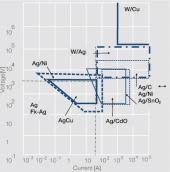Besides the selection of the most suitable contact materials, the design and type of attachment is critical for the reliability and electrical life of contact components for electromechanical switching devices. The most important factors here are the material-saving use of precious metals and the most economical manufacturing method for contact parts..
There are two basic manufacturing solutions available: One can start with single contact parts, such as contact rivets or tips, which then are attached mechanically or by brazing or we...


